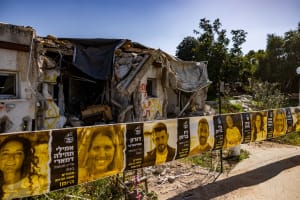Bethlehem, birthplace of rulers and a rich biblical history
Known in biblical times as a place for agriculture, its name in Hebrew is “house of bread”

The city of Bethlehem, in the Judean hills, is famous. Every year, millions of people remember its name as they sing Christmas carols throughout the town where Jesus was born. In countless churches, the Christmas story is read from the Gospels, which mentions the journey of Joseph and Mary to the small town, forced to go by official decree. Children act out the part of the shepherds in Christmas pageants and plays around the world. And the story of a cruel king, willing to order the death of a group of children to remove any threat, reminds us that Bethlehem has not always been a sleepy town, lying beneath the silent stars. Bethlehem, like so many places in the Holy Land, forces us to confront the differences between expectations and painful realities.
Bethlehem has had an enormous impact on the biblical story in relation to its size. It is the birthplace of both King David and Jesus, and yet, it was never the seat of royal administration. The prophet Micah refers to its apparent lack of significance in his famous prophecy, “But you Bethlehem Ephrathah, who are too little to be among the clans of Judah, from you shall come forth for me one who is to be ruler in Israel.” (Micah 5:2)
Bethlehem was known in biblical times as a place for agriculture, its name in Hebrew is “house of bread”, a reference to the grain fields that dotted the landscape around Bethlehem. It was also a place where shepherds raised sheep, its hillsides grooved with sheep and goat trails even to this day. Shepherds who, much like David before them, would spend day and night watching over their flocks, were the first to receive the news of Jesus’ birth. Those shepherds, who were most likely tending sheep to be offered as Passover sacrifices at the Temple, were chosen to witness the birth of the one who would be called the Good Shepherd.
And since that time, whether in song or in pageantry, millions of hearts turn in the direction of Bethlehem. And every year, millions of visitors come to the city of Bethlehem, to see the place where Jesus was born. Outside of Nazareth, Bethlehem hosts one of the largest Christmas celebrations in the Holy Land. The Church of the Nativity in Bethlehem has offered a place of worship and devotion since the sixth century. The church is a unique place, combining three sections from three major groups of Christianity: Roman Catholic, Greek Orthodox, and Armenian Orthodox.
The original church building was erected by the order of Constantine after the visit of his mother, Helena, to Jerusalem and Bethlehem in 325-326 A.D. That building was destroyed in the sixth century during the Samaritan revolts. The Emperor Justinian I ordered the reconstruction of the basilica, in the cruciform style, that was becoming common at that time. The current church has stood since that time, with repairs and some additions. The church was also the location where Jerome translated the Bible into Latin from Hebrew and Greek. Jerome learned Hebrew from local rabbis, and even wrote about some of the differences between rabbinic and Christian interpretation of certain biblical passages.
While Bethlehem experiences its largest crowds during the Christmas season, which lasts a bit longer due to the different reckonings of the major groups, with Roman Catholics and Protestants celebrating Christmas on Dec. 24-25, Greek Orthodox celebrating Christmas on Jan. 7, and Armenian Orthodox celebrating Christmas on Jan. 6 or Jan. 18, depending on the calendar. This spread between dates allows the city to host a greater number of Christmas guests, but one could argue that Christmas visitors come to Bethlehem all year long. Many of the tourists and pilgrims in Bethlehem come to see the birthplace of Christianity.
Born into a time of uncertainty and unrest, Jesus was exposed to the dangers of political tensions from a young age. Around 2,000 years later, that unrest still lingers and a wall of separation runs through part of Bethlehem. The wall is covered with graffiti throughout its length. Even the famous U.K.-based graffiti artist, Banksy, painted several scenes on the wall, protesting the separation and militarization of the area.
The Christian population of Bethlehem, and the Palestinian territories in general, has decreased since the founding of the State of Israel. Some within the Palestinian community blame Israel for the reduction, while others blame it on the rise of militant Islamic movements in Palestinian territories, who have not been friendly to Arab Christians.
The city of Bethlehem is dependent on tourism for much of its livelihood. COVID-19 restrictions hit the city particularly hard, although many are optimistic about a recovery in the tourism sector. While the population of the city may be more Muslim now than in the past, the Palestinian Authority recognizes the importance of Christianity to the history of the city, and so they promote Christian tourism, as well as an annual Christmas parade, which begins in Bethlehem and runs through many other Palestinian cities. Local Christians, Catholic, Orthodox and Evangelicals participate in the parade, creating floats, leading music marches and often handing out treats along the route.
Political pressures still weigh heavily on the little town of Bethlehem, now grown into a city. And it seems the city is still waiting for the message of “peace on earth, goodwill to men” to come to its streets.

The All Israel News Staff is a team of journalists in Israel.













